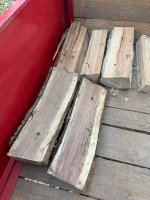WinterDeere
Super Member
- Joined
- Sep 6, 2011
- Messages
- 5,494
- Location
- Philadelphia
- Tractor
- John Deere 3033R, 855 MFWD, 757 ZTrak; IH Cub Cadet 123
There's a lot more to "terrific firewood" than you can get from reading some online BTU charts.Huh? Black walnut is terrific firewood. Most firewood BTU charts show it above 20 MBTU/cord, better than ash, cherry, some oaks and maples.
We average around 10 full cords per year, adding supplemental heat to our too-large and too-old house, thru a pair of Blaze King wood stoves. We burn mostly red oak and hickory that I source from two local properties, although we've been splitting a lot of ash the last few years, thanks to EAB. All of our wood is dried under roof, in open-sided sheds, for 3-4 years before burning.
Black walnut makes up the majority of the trees on our property, and I would estimate maybe 30-40 cords of the last 150 cords I've burned have been black walnut, so I have a good bit of experience in burning it. Maybe more than most will accumulate in a full lifetime.
Its total BTU output isn't terrible, but it's in the lower half of what I'm willing to burn, it's really a waste of your time if you have access to oak or hickory... both of which are massively-prevalent around here. If you're seeing "some oaks" that are worse than black walnuts on your BTU charts, and we assume the chart isn't just dead-wrong (likely), then it must be some rare variety of oak we never see around here. Do be sure all charts are comparing the BTU output at equal moisture contents, as oak takes very long to dry (3-4 years in most climates where one would be burning it), and so it's very easy for one to collect bad data from insufficiently-dried oak.
What likely gives Black Walnut a little boost in BTU content is its high resin content. Resinous woods generally give a good blast of BTU early in the burn, but struggle to maintain heat output over a longer burn cycle, in comparison to less resinous woods of similar total BTU content.
BTU's aside, my real problem with black walnut is the absolutely obscene amount of ash it produces. When you are trying to heat a home with wood, and filling one load after the next into a few wood stoves that never go out October into April, ash accumulation is a constant tedium. Burning most high-BTU hardwoods, I have to empty ash from each of my stoves once per week. But as soon as I switch to black walnut, I need to step that up to more than twice per week.
I will toss black walnut aside, ten times out of ten, when there is oak, hickory, or even ash available. I don't get enough Cherry or Maple to really have an opinion on them, among the woods you mention in your comparison.



